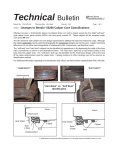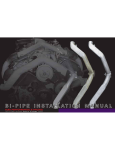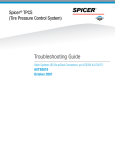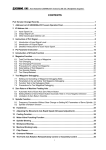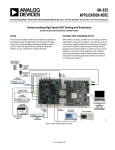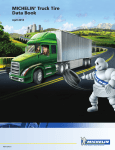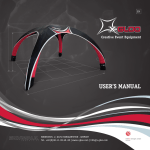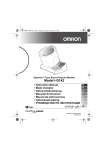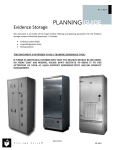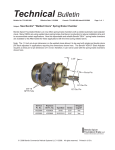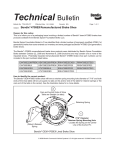Download Spicer® Tire Pressure Control
Transcript
Spicer Tire Pressure Control
®
Questions and Answers About
Reduced Pressure Operation and
Spicer ® Tire Pressure Control
Is the use of reduced tire
pressures approved by the tire
manufacturers?
The tire manufacturers have approved
operation at reduced pressures when limiting the vehicle speeds. Their industry
group, The Tire and Rim Association
(T&RA), has published guidelines which
outline the tire sizes, loads and pressures
to apply this technology. While major
manufacturers have monitored or taken
part in numerous studies to determine the
safety and efficacy of reduced pressure
operation, most tire distributors are either
unaware of the work or are inexperienced
in applying the guidelines. Over time and
with increasing popularity of tire pressure
controlling systems, the awareness of the
tire industry in the field will grow.
Does low pressure work only in
sand? How about mud, clay,
snow and ice?
Reduced tire pressure enhances the
mobility of vehicles through two different
mechanisms, flotation and traction. In
both cases it is the longer footprint associated with reduced pressure operation
that brings about the improvement. (A
steel belted radial tire does not increase
the width of the rubber in contact with the
ground as frequently thought).
To understand the concept of flotation as
it relates to land vehicles, one should
consider the similarity to a water borne
vessel. Just as a loaded ship displaces
water and pushes a discernible “bow
wave” in front of it, a truck on a soft
surface displaces the sand or soil and is
forced to run essentially uphill as it
moves a “wave” of sand in front of it. By
lengthening the footprint, the force exerted by the vehicle on the ground surface,
measured in pounds per square inch
(psi), can be significantly reduced. This
reduction results in a lesser penetration of
the surface by the tire, similar to the
reduction in draft of a ship as its load is
diminished (or the reduced penetration in
snow of a person wearing snowshoes).
This improved flotation allows the vehicle
to move about the surface with less
disturbance to it.
A discussion of traction needs to consider the difference between traction and
friction. Although friction is independent
of area, traction is very dependent on
area. A surface with limited friction will
demonstrate tire slippage with much less
effect on the surface; the tire is slipping
relative to the surface. Limited traction
will show wheel slippage, but with
resulting surface disturbance as the thrust
generated by the tire overcomes the
ability of the soil to resist it. Since a
longer footprint results in a more favorable distribution of shear forces in the
surface, the soil is less likely to be
displaced by the torque of the rotating tire
and increased traction results. Traction
increases (as measured by drawbar pull)
of 60% have been demonstrated solely
through the reduction of tire pressures on
a vehicle in a 6x4 configuration. When
reduced tire pressure is combined with all
wheel drive, improvements of over 100%
are readily achievable.
The combination of improved flotation
and traction results in the possibility of
tremendous improvements in overall
mobility. While these improvements are
most striking in coarse grained soils such
as sand, improvements are also measurable on other soils such as clay and
muskeg. In simplest terms, if operation of
a vehicle results in surface penetration by
the tires, reduced tire pressures and the
resulting improved flotation may help. If
the surface is hard but slippery, reduced
pressures should not have a significant
effect since friction is the dominant limiter
to mobility.
Uneven terrain should also be considered. Reduction in tire pressure will result
in a loss of ground clearance. If operating
in areas with deep ruts, high center
crowns or sharp break overs this can become
an important issue. It can also be noted however, that higher nominal speed capability
stemming from the improved ride and control
when traveling cross-country at reduced
pressures may allow the operator to traverse
some obstacles that could not be crossed at
lower speeds.
Customers should be reminded that one need
not actually install a tire pressure adjustment
system on their vehicle to determine if
reduced pressures will work in their operation. Manual reduction of tire pressure and
reduced speed operation until tires can be
re-inflated will allow most users to prove the
benefits to themselves with a minimal investment in time or money. It should also be
stated that the use of reduced tire pressure
will not prevent one from ever becoming
stuck again, especially when you consider the
prospects that you will be operating in places
where you may not have been previous to
using lower pressures.
How are tire pressure settings
developed?
Tire pressures have been developed to provide the sidewall deflections appropriate for
various tire sizes. Of course, one must
remember that reduced operating speeds are
required to use these reduced pressures.
Generally, tire manufacturers specify on-highway tire pressures to achieve sidewall deflections of 10-13%. These pressures allow
operating speeds up the tire design limit. Offhighway deflections are typically 20-22% and
limit vehicle speeds to 35 mph. Emergency
pressure settings may go to 30% deflection,
with a typical speed limit of 10 mph.
The vehicle owner should always select tire
pressures with the assistance of their tire
supplier. The Tire and Rim Association has
developed reduced pressure and speed charts
to assist in selection of tire pressures.
When did Dana start making tire
inflation systems?
Dana is the world’s leading provider of central
tire inflation systems, having acquired the tire
management businesses in 1999.
Over 35,000 systems have been provided
since 1987 to numerous military and
and commercial programs. These systems
are fielded worldwide and were proven
in Operation Desert Storm as a vital
element of tactical wheeled vehicle mobility.
Several important features account for the
success of the product, among them:
- Depressurized control line strategy
which extends seal life, eliminates tire
leakdown when parked and provides
“fail safe” operating capability.
- Speed sensing to assure that tires are
not operated continuously at cross
country pressures when traveling at
highway speeds.
- Simple push button operation using
pre-set terrain based pressure modes.
- Electronic pressure supply sensing to
assure proper integration with brake and
other on-board air systems.
The Spicer® Tire Pressure Control System,
was introduced to the commercial market in
1994. It is presently available from Kenworth,
Western Star, Volvo, Mack and Peterbilt.
Dana continues to work toward wider
availability of the system.
Tire Pressure Control was created by building
on the same technology used successfully in
the military systems. The following list
represents some of the many enhancements
that have been integrated into the commercial
version:
- Multiple channel operation, allowing the
independent control of pressures on
steer, drive and trailer tires.
- Integration of the wheel valve into the
hub cap using a rotary joint on nondriven axles to simplify installation and
improve reliability.
2
- Introduction of diagnostic tools using
either industry standard devices or
personal computers, simplifying
troubleshooting and repair.
- Publication of troubleshooting, and
service manuals as well as driver
instructions and in-cab aids to improve
driver understanding of systems.
- Wheel valve design improvements to
increase system reliability with longer
trailer combinations and reduce
sensitivity to control system leaks.
- Pneumatic controls design changes to
reduce sensitivity to control system
leaks.
- Introduction of new steer axle products
up to 14,600 lbs. capacity to improve
routing of air to steer wheel ends.
Does Spicer TPCS fit Meritor
drives? Which ones? How about
others?
Spicer drive axle air seal hardware was
developed to fit on the Spicer “R” spindle
configuration. Dana uses this spindle on single axles between 21,000 and 26,000 lbs.
capacity and on tandems from 40,000
through 52,000 lbs. capacity. The “R” configuration meets industry standards for fitment
of wheel end hardware (hubs, bearings, seals
etc.), however individual axle manufacturers
have latitude outside of the specific dimensions for the bearings and the seals to
accommodate manufacturing processes and
other considerations.
Historically, the Meritor “R” configuration has
differed from the Spicer configuration specifically in the width of the outer bearing journal.
It is Dana Corporation’s understanding that
the spindle configuration of the Meritor product was changed in 1999 to accommodate
the hardware required to equip their axles
with Spicer TPCS. The hardware will also fit
on spindles from some other axle manufacturers. We have found that Mack tandems of
38,000 lbs. and 50,000 lbs. will accept the
hardware without modification, however their
44,000 lb. axles will not. Dana will review
axle spindle geometry from other manufacturers at their request if they provide the
necessary drawing information.
What pressure range can the
system control pressures to?
The Spicer System can reduce pressures to
as low as 25 psi, and inflate to 90 psi.
Practically speaking, 90 psi is the max cold
tire pressure setting because of the air system
limitations on most vehicles, where the
compressor cut in is set to 90 psi. (It must be
noted that although the cold setting is limited
to 90 psi, Spicer Tire Pressure Control allows
unlimited pressure rises resulting from heat
generated in the tire. This is essential in that
systems which do not allow unlimited
pressure rises should rightfully have their
pressures programmed to “hot” pressures
which can be 15% higher than cold). Tire
pressures beyond 90 psi can be achieved,
however since the source pressure is very
close to the tire pressure, actual inflation will
be extremely slow. To say that any system can
deliver pressures higher than 90 psi without
consideration of this fact is somewhat
misleading. Realistically, higher tire pressures
will require that the truck air system pressure
be increased to 145-150 psi and that
pressure reducing devices be installed for
vehicle braking and other systems.
Another detail which is important to note
involves the physics of moisture control.
Spicer Tire Pressure Controls utilize an operating regime which minimizes the possibility
of moisture accumulating in the tires by
forcing all of the air to be compressed to a
level higher than that to which the tires will be
inflated. Since all of the air going to the tires
will be less than this peak pressure, it will be
even dryer than when it left the on board air
dryer since it has been expanded. Such a
regime is critical for proper long term system
operating reliability and keeping moisture out
of the tires where it can have long term
consequences. Systems which do not use
such a regime may appear to be working
when they are not, as they do not signal
inability to change pressures to the operator.
Finally, the issue of safety cannot be ignored.
The design of Dana’s Tire Pressure Control
demands that vehicle air brake reservoirs be
brought to a high pressure level before any
tire pressure checking or changing operation
be allowed to begin, not merely the minimum
governor cut in level. Other systems may be
programmable to allow higher tire pressure
settings, but pressures above governor cut in
come at the expense of high brake reserve
pressures. Dana considers high vehicle braking reserve pressures an essential
element of vehicle safety and therefore prefers
to use the margins between governor cut in
and cut out to assure maintenance of these
reserve pressure levels. Dana feels that any
strategy which reduces the average braking
reserve levels or substantially increases the
time required to achieve those levels violates
the intent and spirit of regulations such as
FMVSS 121.
How long does it take for inflation
and deflation?
Any discussion of inflation and deflation
times must consider many factors such as
tire volumes, pressure settings and compressor capacities to adequately address the
issue. One must also distinguish between the
time required to change the pressure in a
given group of tires and the time required for
a system to signal that a pressure changing
operation has been completed.
For example, the Spicer® Tire Pressure
Control System can, through its wheel valve,
reduce the pressure in a 11R24.5 dual set
from 90 psi to 45 psi (a 3 atmosphere reduction) in approximately 2 minutes, but the system may indicate that the operation has not
been completed for more than three minutes.
Several factors may influence this time. First,
the system checks to assure that brake pressure reserves are maintained and may suspend operations which change pressures to
give this first priority. Second, the system
monitors itself to assure that deflation can
proceed reliably and deflation may be delayed
while the system assures that all deflation
parameters are properly met. Finally, to
assure that tire pressures are balanced
following a deflation sequence, Spicer Tire
Pressure Controls are programmed to go
through a short reinflation period to bring all
pressures within the proper limits.
Inflation times are affected by even more
factors, primarily related to overall tire volume
and compressor output. The Spicer® Tire
Pressure Control System has been designed
to work on a wide range of trucks and truck
configurations and as such will work with
most any compressor output (presuming the
compressor is in good operating condition).
The issue of inflation time requirements
deserves some discussion. Over the past ten
years, numerous test results have been documented which show that the use of on-board
controls to adjust tire pressures does not
reduce tire life. Tire manufacturers have
suggested that tire durability will not be
compromised as long as inflation capability
is sufficient to inflate tires to 75% of the recommended cold highway pressure within 15
minutes of achieving highway speed, and
100% in 25 minutes. This guideline can lead
the person spec’ing the vehicle to an approximation of required compressor capacity
using the simple analysis below. Dana urges
those who are considering the use of Tire
Pressure Control technology to work closely
with their tire supplier to obtain the information needed about tire volumes and operating
pressures as well as suggested inflation times
for their application.
In simple terms, inflation time can be
approximated by dividing the internal volume
of the tires by the compressor output, and
multiplying the result by the amount of the
desired pressure increase. In order for this to
work however, all terms must have compatible units – tire volume in cubic feet (ft3),
compressor output in standard cubic feet per
minute (SCFM) and pressure increase in
atmospheres (atm.). Atmospheres can be
found by dividing the pressure increase in
psi by 14.7. A formula for this can be
expressed as:
{Volume (ft3) / Output (SCFM)} X Pressure
Increase (psi) / 14.7 (psi) = Time (min)
3
Since the Spicer Tire Pressure Control
System allows the independent control of
pressures on steer, drive and trailer tire
groups, the times must be calculated for each
of the channels and added together for a total
time. For example, let’s presume a typical 18
wheel tractor trailer combination, with two
tires on the steer channel and eight each on
the drive and trailer axle groups, an internal
tire volume of 4.5 ft3 for each tire and a
compressor output of 13.2 SCFM. (Typically,
compressor output is rated at a nominal
engine output speed such as 1250 RPM).
Furthermore, lets presume the following
pressure increases between the off highway
and highway pressure settings:
Channel
Steers Drives Trailers -
Off Hwy
70
55
50
Highway
90
90
90
Increase
20
35
40
The analysis would be as follows:
Steer Channel
{(2x4.5)/13.2} X 20/14.7 = .9 minutes
Drive Channel
{(8x4.5)/13.2} X 35/14.7 = 6.5 minutes
Trailer Channel
{(8x4.5)/13.2} X 40/14.7 = 7.4 minutes
Total Time
.9 + 6.5 + 7.4 = 14.8 min.
This analysis is only an approximation. It
does not take into account several major
factors such as compressor efficiency (which
will change over time) or engine speed (inflation time can be improved by downshifting
until highway pressures are achieved), or
numerous minor factors (such as atmospheric variables or the compressibility factor of
air). It should suffice however, to guide one
through the task of compressor selection. The
use of turbo-charged compressors can result
in inflation times that improve as engine
loads are increased only up to the limit of the
system’s ability to use the air (approximately
20 SCFM), but this improvement should be
weighed against its impact on compressor
life and overall vehicle air system design.
Too much air can be detrimental to system
4
performance as the excessive compressor
temperatures generated can result in a higher
level of contamination (oil blow-by) and
reduced air dryer effectiveness, possibly
requiring the use of additional means to
cool the air, such as condensers and
heat exchangers.
How does one diagnose service
items for TPCS?
The Spicer ® TPCS wiring harness includes a
connector which meets industry standard
requirements for connection to modern
diagnostic tools. The interface is fully
compatible with other vehicle systems to also
allow connection through a central OEM
supplied connector interface. Both hand held
tools, such as those from MPSI, and personal
computers may be used. Use of a personal
computer requires the purchase of a serial
interface connector (such as Kent Moore part
number J38351 or B&B Electronics part
number 232ESAER) to make the connection.
By plugging the tool connector into the TPCS
diagnostic connector, the technician can do a
complete diagnostic analysis of the system,
including retrieval of historic service codes.
Diagnostic software discs are available for
System users at no charge from Dana Spicer
Heavy Axle and Brake Division.
How does the Spicer System detect
tire imbalances and low tires?
The Spicer® Tire Pressure Control System
uses sophisticated microcomputer technology and has extraordinary capability to analyze
information. Dana engineers have developed
algorithms for the System which critically
evaluate many details of operation. Much of
this evaluation is done in the short period of
time between initiation of a pressure check
(or selection of a new pressure mode) and
the decision to proceed with a change
of pressure.
The System evaluates the pneumatic signature from the time of the wheel valve opening
pulse to the time of the actual pressure reading. During this period, approximately two
seconds, the pneumatic response of the
System is compared to acceptable responses
stored in the memory of the controller. If the
response merely indicates that the pressure of
a given channel is low, inflation will be initiated. If the response indicates that pressure is
higher than that requested, a deflation will be
commanded. Other responses may indicate
something less than acceptable readiness for
the change of tire pressure and trigger a
service code so the driver can evaluate how
best to proceed.
The signature analysis technique allows the
system to detect if one tire is significantly out
of balance from the others in the same axle
group. Parameters for the low tire detection
have been established to trigger the “check
tire” icon when the pressure in one wheel
end of a channel group is approximately 50%
or less than the others in the group. Since
such a loss of pressure could have occurred
over the 5 to 15 minute pressure check interval, a substantial tire leak could be indicated
and therefore, the driver may also see an 11!P
code indicated after the completion of a pressure changing sequence. The driver should
physically inspect the tires on the affected
axle group for possible leaks or damage
before proceeding. If a tire puncture is found,
the driver may select the run-flat key to
reduce the interval of tire pressure checks to
15 seconds and thereby use the system to
keep the tire inflated. If the tire damage is significant, the system will not be able to keep
up with the leak and a 9P! or 10!P code may
result. In this event, the vehicle may require
immediate tire repair. –It is important to note
that tire damage is not always readily visible
and that operators should use care in determining the extent of tire damage. The only
reliable way to determine which tire is
low is to use a pressure gage and
inspect any tire which measures low.
Frequently, out of balance tire pressure conditions occur on start-up after the vehicle has
been idle for extended periods (such as
weekends) as a result of slow leaks in the tire
and wheel assembly. The system can help to
identify these leaks early enough that the
observant owner can have small leaks
repaired before they become larger leaks
which force downtime and limit retreadability.
It must also be noted that pneumatic control
system leakage can mimic the pneumatic
signature for an 11P! code, and result in false
alarms. In this case, the operator can use run
flat to proceed, however the system should be
serviced as soon as possible since leaks will
always get worse over time and eventually
cause additional service messages and make
diagnosis and repair more difficult. The use
of service diagnostic tools will greatly simplify the identification and repair of leaks.
How does the air get to the tires?
Air is routed to the tires via air seals which
have been installed in the axles. Two
approaches are used, one for non-driven
axles (steers and trailers or tag axles) and
another for drive axles. Air is routed through
the center of non-driven axles and through a
rotary joint which is mounted on the end of
the spindle. Driven axles utilize a patented air
sleeve in conjunction with a special hub.
Once the air is passed through the hub or
hub cap, it is connected through the wheel
valve to the rim with an air hose. It is important to remember that wheels and hubs need
to be positioned properly relative to each
other to assure proper fit of the hoses to the
valve stems. Failure to do so may result in
stress on the hose or valve stem that can
result in air leakage and improper operation.
If an air line ruptures, do I lose all
of the air in the system?
The Spicer ® Tire Pressure Control System
utilizes wheel valves to assure that air is not
lost from the system in the event of air line
breakage. Air pressure only exists in the
control lines of the system when measuring,
inflating or deflating the tires. (Only the hoses
between the tires and the wheel valves are
normally pressurized). Failure of a control
line is sensed by the system and the affected
channel is shut down and the operator
notified through a service message. This
depressurized operation also guarantees that
tires will not leak down through the air seals
while the vehicle is parked, even for
extended periods.
How do the wheel valves work?
Can they malfunction?
The wheel valve is an essential part of the
Spicer System which improves overall system safety and reliability by allowing control
lines to be depressurized unless actually
inflating, deflating or measuring tire pressures. It is an extremely simple device consisting of spring loaded diaphragms biased
against seats to contain air to the wheel end.
In the absence of a control signal, the springs
act against the diaphragms and seats to close
the valve. Positive pressure signals are used
to measure and inflate tires, negative pressures are used to deflate.
As a result of the simple design, the wheel
valves possess an inherent high reliability,
even in the environment of a truck air system.
In fact, similar diaphragm and spring concepts are used in most of the valves used in a
trucks today because of their high reliability
and ability to tolerate wide temperature
ranges and some level of contamination. The
biggest difference between the Spicer® Tire
Pressure Control System and other systems
used on the truck is in the volume of air used.
Since inflating tires uses a large volume of
air, possibilities of contamination are greater.
Contamination is the largest single reason for
wheel valve malfunction. Measures must be
taken to prevent contamination from entering
the system.
Each wheel valve includes a filter in the port
which connects it to the tire. These filters are
intended to trap contaminants contained in
the tire and prevent them from entering the
wheel valves, and should be changed at any
time the tire is removed, either for rotation or
replacement. Service technicians must be
careful not to damage the filter by installing
adjustable fittings too deeply into the tire port.
To do so will crush the filter and possibly tear
it. Instructions in the service manual should
be followed closely.
Care must also be taken to prevent
contaminant entry any time control air lines
are disconnected. Trailer couplings are
especially critical as they may frequently be
disconnected with the trailer. For this reason,
Spicer recommends the use of an in-line air
filter in the trailer line, to prevent contamination from entering the coupling and traveling
to the trailer wheel valves. It is also important
to blow any debris from hoses, tubing and
fittings when servicing the vehicle. Instances
have been encountered wherein hose slivers
from the initial installation have been trapped
in the system, causing problems later.
What is the minimum temperature
for operation?
The Spicer® Tire Pressure Control System
has been developed using the same industry
standards for operation to -40 degrees as
most vehicle components. Operation at temperatures below that is possible, however
some service codes may be encountered
under extremely cold conditions which may
disappear when either the component warms
up under use or from increasing ambient
temperatures. These may include codes
related to temperature induced leakages, as
extremely cold temperatures will cause
materials to shrink and reduce the effectiveness of sealing. Dana recommends that the
pneumatic control unit be placed in the cab
wherever cold weather is encountered so that
cab heat can assist in warming the unit to
enable operation.
While system operation is possible at low
temperatures, the primary reason for problems at temperatures below freezing is not
with the system components, but with the
effectiveness and maintenance of air drying
equipment. Extremely cold air has very little
moisture in it, while warm air can hold
tremendous amounts. In fact, at +80°F
(+27°C), atmospheric air can hold almost 50
times more water than at -13°F (-25°C).
Failure to monitor and maintain the air
system during warmer months will result in
entrained moisture in the air tanks and system components that are certain to cause
problems as temperatures fall. Failure to routinely drain air tanks can result in whole water
passing from the tanks through the system,
and even into the tires where it can inhibit the
5
system’s ability to deflate even at temperatures of +65°F (18°C). Although the Spicer
System minimizes the possibility of condensed water in the controls and the tires,
whole water can only be controlled by positively draining all water which has condensed
from the tanks. Proper preventative maintenance demands draining all tanks to zero
pressure whenever the truck is to be left
unused for an extended period.
jawed locking plier or other tool may be used
to temporarily crimp the hose). After putting
the new tire in position, the hoses must be
replaced and properly restrained to prevent
damage. While inflating, following completion of a tire change, the system may display
a “check tire” icon, indicating that air in one
tire is lower than others on the channel. This
indication should clear after the system is
used to inflate the tires.
Does a standard truck air
compressor satisfy the
requirements for TPC?
Is the system reliable in sandy
and/or dusty environments?
Air compressor output capacity requirements
are determined by factors such as the total
internal volume of the tires being controlled
and the pressure range over which one is
operating the tires. While in some cases a
manufacturer’s “standard” compressor may
be appropriate, it will not be in others.
Specifying too much air capacity can also be
harmful by causing additional heat which
results in oil consumption that will contaminate the system. Owners, dealers and manufacturers will need to consider the application
when specifying the compressor.
Manufacturers will also need to work with
compressor and air dryer suppliers to assure
the factory installed air system will meet the
needs of the user. Compressor and dryer
manufacturers may have established specific
installation requirements for the use of their
products with high air usage systems such as
Spicer ® Tire Pressure Control.
Is it more difficult to change tires
on a TPCS equipped truck?
Tire changes on a TPCS equipped truck will
require additional steps, which although not
difficult, will add to the amount of work
required. The technician will need to take care
and note or mark the location of the wheel
relative to the hub to assure that the new
wheel is installed in proper position to
reconnect the hoses when complete. Prior to
removing the tire, he must disconnect the air
lines and plug or cap them if the tire is still
pressurized as there are no valve cores in the
stem of a TPCS controlled wheel. (A smooth
6
The Spicer® Tire Pressure Control System
uses many of the same operating principles
of the Spicer® Central Tire Inflation System
which was so successful in Operation Desert
Storm. Over 5,000 systems were fielded in
that effort without any reported failures. The
desert terrain of Saudi Arabia and Kuwait
(and Iraq) represents some of the harshest
conditions in the world. The commercial system has been tested across the United States
in wide ranging environments for over 1.5
million miles prior to production.
What is the maintenance impact of
adding a system to my truck?
Several items should be looked at from a
maintenance perspective when using vehicles
equipped with Spicer® Tire Pressure Control.
Wheel Valve Filters – The first item is the
wheel valve filters. Filters are included in each
wheel valve in the air connection to the tire
hose. This filter traps debris from the tire and
helps to assure reliable wheel valve operation. Even tires which were clean during
mounting have been found to have loose
debris in them after many hours of operation
and it is important that this debris not get into
the wheel valve. Dana recommends that these
filters be changed whenever tires are rotated
or replaced. Since it is difficult to determine
how long it takes for this tire dirt to develop,
your application may demand more frequent
changing. Tires which deflate to uneven pressures within the same axle group would be a
reason to look at changing the filters.
Non-driven Wheel End Lubrication – Another
item is the area of wheel end lubrication for
non-driven wheel ends, such as steers and
trailers. In order to deliver air to a tire, a
system must route air through the wheel end
via a rotary joint inside the hub cap. If air
were to leak from this rotary joint and pressurize the wheel end, the main inboard oil
seal could be damaged or displaced. The
Spicer® Tire Pressure Control System utilizes
a special plug in the center of the hub cap
window which vents easily to make build-up
of pressure in the wheel end unlikely, and the
hub cap itself has been designed to mount
the wheel valves to provide a neat package for
steer axles.
Since the hub cap section is not uniform, the
apparent oil level in the wheel end will vary
depending on the position of the hub cap
when the vehicle is stopped. The addition of
oil to the wheel end should always be done
through the fill plug in the side of the hub
cap, not the vent plug in the window, since
the lines on the window are the appropriate
oil level only when the fill plug is at 12
o’clock. Adding lubricant to the lines with the
fill plug in any other position may result in an
over-filled condition and oil will likely leak
past the low pressure vent plug, resulting in
an unsightly leak. Furthermore, water or
detergent spray should never be directed at
the vent plug, as it can get past the plug and
enter the hub cap, contaminating the oil and
reducing wheel end life. Oil should be examined frequently for such contamination, and
be changed if any oil discoloration is found.
Many applications for Tire Pressure Control
are severe duty applications which demand
routine wheel end inspection of bearings on
an annual or semi-annual basis. You should
always follow the manufacturer’s recommendations for wheel end service.
Drive Axle Wheel Ends – While the addition
of air seals into the drive axle hubs does
not create any unique requirements for
maintenance of the wheel end, it does make
adherence to current recommended maintenance practices more important to assure the
best life from the seals.
Wheel bearing adjustment is just as important
to good air seal life as it is to good oil seal
life. Improper adjustment allows excessive
play and runout in the seal and results in
reduced seal performance. Always follow the
recommended practices of the axle supplier
and The Maintenance Council of the
American Trucking Associations to assure
satisfactory performance.
It is very important that seals which are
performing properly not be disturbed
unnecessarily during routine maintenance for
brakes or other wheel end repairs. The wheel
end equipment utilizes an outboard mounted
brake drum design so that brake repairs can
be made without disturbing the hub. Removal
of the wheels with the hub and brake drum as
a unit is not recommended, and may necessitate replacement of all seals, both air and oil.
Even if these seals are to be replaced, proper
installation will be extremely difficult with the
wheels and drums attached to the hub, with a
higher likelihood of damage to the seal. The
specification of hub piloted wheel designs
allows the removal of dual wheels with only
ten fasteners, avoiding the additional labor
requirements of older stud piloted designs.
Vehicle Air System – A final area demanding
additional maintenance attention is the vehicle air system, including the compressor and
the dryer. The adjustment of tire pressures
requires the use of far more air than normal,
where air is used primarily for braking.
Increases in both compressor duty cycle
(percent on time) and continuous on time
make the load on the air system far more
severe and demanding of special attention.
As the actual air system impact is strongly
dependent on the application, i.e. how frequently the tire pressure system is being
used to adjust pressures, it is not possible to
predict with certainty how often a particular
fleet or owner will need to service the compressor and air dryer, but it is essential for
users to determine a maintenance cycle that
works for their application. While getting
acquainted with the use of Tire Pressure
Control in your operation you should pay
particular attention to the air dryer to
determine a proper service interval for you.
Initially, a daily look at the discharge from the
dryer will tell you if the system is working
properly. Oil or any discharge other than
water is cause for investigation and correction. Maintenance personnel should also be
checking air dryer cartridges and the air
supply tank for signs of contamination
monthly until the first replacement is
necessary, and then checking cartridges at an
interval half way to the period of the first
change until you are comfortable with the rate
at which they are losing effectiveness.
Operators should also be instructed to drain
the vehicle supply tank from which the
system draws its supply completely every
night. Any water observed coming from the
tank while draining deserves to be looked
into, as a properly working air dryer will not
allow water into the air tank during a working
day. Manual drain valves should be installed
which do not require the operator to stand by
the truck while the tank is depleted to zero
psi, as even air from a properly working air
system contains sufficient moisture to
condense in the tank during overnight drops
in ambient temperature.
Removal and replacement of drive axle hubs
will also demand addition of lube through the
hub lube fill hole to assure sufficient wheel
end lubrication to the inner bearing. This
lubrication must be added after the axle
shafts, but before the wheels are installed.
7
For spec‘ing or service assistance, call 1-877-777-5360 or visit our website at www.dana.com
Dana Commercial Vehicle Products Group
3939 Technology Drive
Maumee, Ohio, USA 43537
www.dana.com
All applications must be approved by the Application Engineering Department. Specifications and/or design are subject to change without notice or obligation.
Printed in USA
AXSL-0012 12/99








